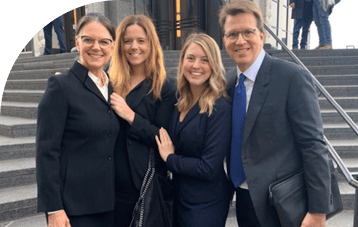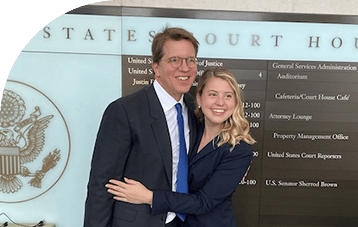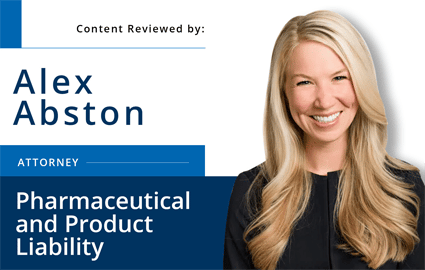Opioid Lawsuits
Home » Practice Areas » Pharmaceutical Liability » Opioid Lawsuits
The Lanier Law Firm is passionate about ensuring that all parties are held responsible for their role in the opioid public health crisis. We are proud to help communities, state attorneys general, and municipalities across the nation pursue justice on behalf of those affected by the devastating consequences of the opioid epidemic.
Origins of The Opioid Epidemic
Opioids are powerful pharmaceutical drugs prescribed to treat chronic pain. Opioids are derived from naturally occurring opium, which has been used to treat pain for centuries. These prescription painkillers can be highly addictive when used improperly. Opioid addiction inevitably leads to the use of harder illicit drugs like heroin and fentanyl. This devastating epidemic continues to destroy communities, increase crime rates, and impact the fatal overdose rate.
Nearly 294,000 people in the United States died of prescription opioid overdoses from 1999 to 2022. More than 100,000 people lost their lives to opioid overdose in the first twelve months of the COVID-19 pandemic, the highest number ever in one year. Correspondingly, prescription opiate addiction also increases the demand for illegal opiates. The increasing rates of opioid addiction have led the government, public health officials, and medical professionals to declare an official opioid epidemic.
Companies that manufacture, distribute, and dispense opioids have certain legal responsibilities. These pharmaceutical entities know that opioid products have dangerous and deadly risks. Pharmaceutical companies — specifically drug manufacturers, distributors, pharmacies, and pharmacy benefit managers — continue to profit from the surplus of opioids circulating in American communities.
Communities, families, victims, and state and local governments pay the price for these companies’ choices. Every day our state and local governments grapple with the mounting costs associated with increased drug overdose and death rates, growing crime rates, the demand on family and emergency services, and the need for accessible treatment resources.
Who is responsible for the opioid crisis?
There is not one person or company responsible for the opioid crisis. Many entities have contributed to the significant and accessible supply of these dangerously addictive drugs. For too long, companies have profited from the opioid epidemic without consequence. The following parties have all played a role in creating the opioid epidemic:
- Pharmaceutical companies, including pharmaceutical manufacturers and distributors, have misled health-care providers and the public about their products’ addictive properties.
- Medical professionals have been misled into prescribing these highly addictive opioid drugs beyond their Food and Drug Administration-approved use.
- Pharmacies have bypassed their legal obligations and improperly dispensed opioid drugs to patients without first completing proper due diligence.
- Individuals can also bear some personal responsibility for illegally selling or distributing opioids.
All parties must be held accountable for their role in perpetuating the devastating opioid epidemic plaguing our country.
Get Free Case Consultation
By submitting this form, you agree to our terms & conditions. Please read full disclaimer here.
The Role Of Litigation
The Lanier Law Firm is currently involved in various multi-district and state litigations seeking to hold all members of the drug supply chain accountable for the devastating costs of their actions.

How Opioid Litigation Began
The Purdue Frederick Company was founded in the late 1800s. In the 1950s, the company was purchased by the Sackler family, and the name was shortened to Purdue Pharma in the 1990s. The drugmaker was at the forefront in creating the opioid prescription market that we see today. Purdue Pharma manufactured hydromorphone and oxycodone, amongst other drugs, to create branded pain-relieving drugs known as MS Contin and OxyContin.
Their blockbuster product, OxyContin, was an extended-release version of oxycodone. Purdue Pharma used aggressive and dishonest marketing tactics to promote Oxycontin. It was later discovered that Purdue downplayed the addictive nature of the drug. Most notably, Purdue falsely claimed the drug would be unappealing to recreational users due to its slow-release mechanism.
In the early 2000’s, Purdue Pharma and the Sackler family began to face litigation over the addictive nature of their best-selling painkiller. The United States Department of Justice also began to investigate Purdue Pharma. An investigation by the Justice Department revealed Purdue Pharma knew early on that Oxycontin was being significantly abused on the street. The investigative report uncovered that company officials received dozens of reports showing strong evidence that Oxycontin was a coveted street drug:
- The pills were being crushed and snorted.
- Pharmacies were being robbed of Oxycontin.
- Doctors were being criminally charged with selling prescriptions.
Executives from Purdue Pharma claimed they did not have this knowledge until the year 2000, but their internal documents proved otherwise. Their conduct was so egregious that federal prosecutors recommended charging top company executives with felonies.
Ongoing Litigation Against Purdue Pharma
Thousands of civil claims have been filed against Purdue Pharma and the Sackler family for their role in the opioid epidemic. These suits have been brought by individual victims, municipalities, hospitals, tribes, and states. Purdue Pharma filed for Chapter 11 bankruptcy in 2019. Under the latest settlement plan, the Sackler family and their company will pay as much as $6 billion dollars to states and municipalities across the nation. The funds will be used to assist in the prevention and treatment of opioid addiction
The National Prescription Opiate Litigation
More than 3,000 opioid cases have been consolidated in Cleveland federal court. Named defendants include Purdue Pharma and other manufacturers, distributors, pharmacies, and pharmacy benefit managers.
The MDL eases congestion in the courts and aims to help bring about a speedier resolution. MDLs differ from class-action lawsuits. Unlike class-action lawsuits, MDL cases are assigned to one federal court, but they maintain their separate nature. The MDL Judge typically chooses a few test cases, also known as bellwether cases. The bellwether results provide insight into what might happen in the other cases and further the goal of global resolution of all cases. This procedural mechanism streamlines the process and can impact decisions on whether to settle and for how much.
The Lanier Law Firm's Results
The Lanier Law Firm is currently involved in several multi-district and state litigations where we seek to hold all members of the drug supply chain accountable for the devastating costs of their actions.
Settlement Against Drug Distributors and Manufacturers in Ohio
In 2019, Mark Lanier was prepared to try the inaugural MDL bellwether case against opioid distributors AmerisourceBergen, McKesson, and Cardinal Health, plus pharmaceutical manufacturer, Teva. Summit County and Cuyahoga County, located in Ohio, were selected to as the first bellwether case set for trial within the growing MDL. Just one night before the trial was set to begin, the remaining defendants agreed to a $260 million settlement. The proceeds of the settlement will be used by the counties to get their citizens into treatment, assist first responders, and create programs that combat the daily challenges of the opioid epidemic.
Historic Opioid Settlement in Texas
The Lanier Law Firm’s Dara Hegar, together with the Texas Attorney General and other trial lawyers, negotiated a $1.85 billion opioid settlement in a case against opioid manufacturers and distributors. The settling entities include McKesson Corporation, Cardinal Health, AmerisourceBergen, and Johnson & Johnson. This settlement contains significant abatement monies that will be used to help state and local governments cope with the opioid epidemic, fund education, and establish treatment programs throughout the state.
Landmark Verdict Against Walmart, Walgreens, and CVS Pharmacies
Mark Lanier, along with Peter Weinberger of Spangenberg Shibley & Liber LLP and Frank Gallucci of Plevin & Gallucci Co., achieved the nation’s first ever jury verdict on behalf of two Ohio counties, Lake County and Trumbull County. The jury sided with the counties in the suit against three pharmacy giants — Walmart, CVS, and Walgreens — that were ordered to pay $650 million to the two Ohio counties. Attorney Mark Lanier argued these actions specifically violated public nuisance laws. The historic verdict sets a precedent that holds American pharmacies responsible for their role in the opioid epidemic.
In Lake County, 61 million pills were distributed between 2012 and 2016. That is enough for every resident to receive 265 pills. In Trumbull County, 80 million pills were distributed, which is enough for every resident to receive 400 pills. The resulting addiction in these counties led to a steep increase in heroin and fentanyl use and drug overdose fatalities.
“Everybody in America has responsibility under the law,” Mark Lanier stated in an interview with journalist Gene Valicenti. “Corporations and businesses are no different, and if we transgress the law, a jury is going to hold us accountable, and that’s the beauty of the American justice system.”
The Ohio case resulted in a momentous verdict that held these pharmacies liable for the oversupply of opiates in Lake and Trumbull counties.

Jayne Conroy of Simmons Hanly Conroy with Mildred Conroy, Rachel Lanier and Mark Lanier.

Mark Lanier and Rachel Lanier.

Lanier Law Firm Opioid Trial Team
By submitting this form, you agree to our terms & conditions. Please read full disclaimer here.





